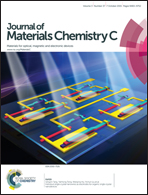Enhancing the performance of polymer solar cells by tuning the drying process of blend films via changing side chains and using solvent additives†
Abstract
A series of new conjugated polymers (P1–P3) with 3,6-difluorocarbazole as a donor unit and benzoxadiazole as an acceptor unit were synthesized and used as donor materials for polymer solar cells (PSCs). The morphology of blend films was regulated by controlling the drying process via tuning the solubility of polymers and using solvent additives. Enhancing the solubility of polymers via increasing the volume of side chains can decrease the domain size of polymers and using 1,8-diiodooctane (DIO) as a solvent additive can give an even better vertical phase separation, leading to a significant enhancement of the power conversion efficiency (PCE) of up to 5.71% for P3 based PSCs. The improving of the interface between polymers and PC71BM phases as well as the formation of vertical phase separation after using DIO as an additive are probably responsible for the high open circuit voltage (Voc) of devices.


 Please wait while we load your content...
Please wait while we load your content...